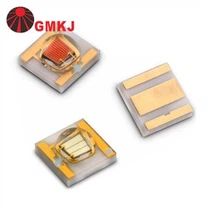In the PCBA processing industry, due to the small size of SMD LEDs, low power consumption, long service life, high brightness, environmental protection, sturdiness and durability, suitable for mass production, fast response, shockproof, energy saving, high resolution, shock resistance, Advantages such as design will be applied to light-emitting diodes in many fields. It is often necessary to weld the SMD LEDs during use. At this time, it is necessary to judge the positive and negative poles of the SMD LEDs to complete the welding. So how can we quickly determine the positive and negative poles of the SMD LEDs?
1. Look at the diode pin
In the conventional case, the long leg is positive and the short leg is negative. If the two legs are the same length, the small dot in the LED is the positive pole and the larger one is the negative pole.

2. Use testing tools
Use a multimeter to test the light-emitting diode, connect the red test lead to positive and the black test lead to negative. Note: When testing light-emitting diodes, if the low range cannot be measured, you can use RX10K to test. When the two test leads are in contact with the positive and negative poles of the diode, when the resistance is small, the black test lead is connected to the anode of the diode, which has a higher resistance. When it is large, the black test lead is the cathode of the diode.
What state is displayed when the multimeter tests the positive and negative poles of the light-emitting diodes?
The red and black test leads of the multimeter Rx1k file are alternately connected to the two leads of the flashing light-emitting diode. When one of the measurements is found, the needle first swings to the right for a certain distance, and then the needle starts to jitter (vibrate) slightly at this position, with a swing amplitude of one Around the small grid. This phenomenon shows that the integrated circuit inside the self-flashing light-emitting diode starts to oscillate under the action of the 1.5V battery voltage inside the multimeter, and the output pulse current makes the pointer jitter, but the voltage is too low to make the light-emitting diode light. However, this phenomenon shows that the connection of the red and black test leads of the multimeter is correct, that is, the black test leads of the multimeter are connected to the positive electrode of the self-flashing light-emitting diode.
3. Look at the missing corner of the diode
In the LED energy-saving lamp lighting industry, 5050 SMD LEDs are often used. This SMD LED is square. One of the four right angles has a small corner, and the end with the small corner is the negative electrode. One end is the positive electrode.

4. Look at the diode product identification
SMD LEDs packaged in 0805 and 0603 will have a "T" or inverted triangle symbol on the bottom. One side of the "T" is the positive pole and the other side is the negative pole; the triangle symbol's "side" is close to the positive, "corner" "The one that is close is the negative electrode.

5. Look at the shape of the LED
From the side of the light-emitting diode, there will be two lead wires in the shape of the tube, the smaller one is the positive electrode, and the larger one is the negative electrode.

Related information polypropylene vs abs plastic






